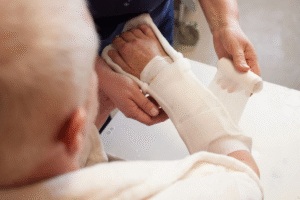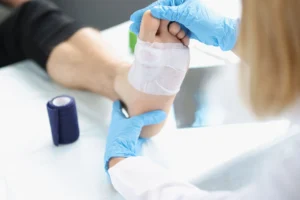Diabetic gangrene presents a significant health challenge by causing tissue death resulting from reduced blood circulation and infections. This condition, which most often affects the lower extremities in individuals with diabetes, requires swift and skilled medical intervention. At Tec Orthopedics, patients benefit from an integrated treatment approach designed to manage infection, preserve as much healthy tissue as possible, and support overall mobility. This article will provide an in-depth look at how our dedicated team tackles this severe condition through precision orthopedic treatment for diabetic gangrene.
Understanding Diabetic Gangrene
Diabetic gangrene is a critical complication predominantly impacting individuals with long-term diabetes. The process begins when decreased blood circulation—common among those with diabetes—limits the delivery of oxygen and nutrients to cells. Without these essentials, tissues become vulnerable to infections. Once an infection sets in, the tissue damage can advance rapidly, eventually leading to gangrene.
Key points to consider include:
- Circulatory Complications: High blood sugar levels over time can damage blood vessels, especially in the extremities, making it more difficult for tissues to repair themselves.
- Infections: Bacterial invasions can quickly worsen the condition. Once the tissue is infected, the body’s immune response may not be sufficient to stop the spread, necessitating aggressive intervention.
- Lower Extremity Vulnerability: Feet and legs are particularly susceptible due to their distance from the heart and resulting reduced blood flow, amplifying the risk of gangrene.
Early recognition of symptoms is essential for preventing further complications, and clinical intervention should be undertaken as soon as the signs of tissue degradation or infection appear.
The Role of Orthopedic Intervention
Orthopedic treatment for diabetic gangrene is critical in addressing the many complications associated with the condition. The primary goals of this medical intervention are to:
- Control the Infection: Using targeted antibiotics and other medications to suppress the infection.
- Preserve Healthy Tissue: Surgical and non-surgical methods are employed to remove dead or infected tissue while aiming to retain as much viable tissue as possible.
- Improve Mobility: Rehabilitation and supportive devices help maintain and, where possible, restore mobility, reducing long-term disability.
Orthopedic treatment is not only about addressing the immediate threat of infection but also about setting the stage for recovery. By focusing on controlling the damage and supporting the patient’s mobility, the team at Tec Orthopedics helps patients avoid further complications such as sepsis or systemic infections, which can be life-threatening.
Diagnosing Diabetic Gangrene
Accurate diagnosis is a critical step in successfully treating diabetic gangrene. The diagnostic process typically includes:
- Initial Assessment: A thorough evaluation of the patient’s medical history, paying particular attention to diabetes management, any previous infections, and signs of vascular problems.
- Physical Examinations: Healthcare professionals examine the affected area for typical symptoms such as discoloration, blistering, numbness, or severe pain.
- Imaging Tests: X-rays, MRIs, or CT scans may be used to assess the extent of tissue damage and detect any involvement of bones or joints.
- Laboratory Tests: Blood tests can reveal markers of infection and inflammation, and tissue cultures help identify the specific bacteria responsible for the infection.
Early detection is a cornerstone of effective treatment. Prompt diagnosis enables the medical team to initiate orthopedic treatment for diabetic gangrene quickly, reducing the likelihood of the condition spreading further.
Comprehensive Treatment Strategies
The treatment protocol for diabetic gangrene consists of multiple strategies coordinated to address both immediate and long-term health concerns:
Infection Management
Managing infection is the first and most urgent step in treating diabetic gangrene:
- Antibiotic Therapy: Targeted antibiotics are administered to combat the bacterial infection effectively. In many cases, this treatment is tailored based on the specific pathogen identified in laboratory tests.
- Surgical Debridement: In instances where the infection has resulted in significant tissue death, surgical removal of the necrotic areas may be necessary. This procedure helps prevent the spread of infection and allows the remaining healthy tissue a better chance to recover.
It is imperative that the infection is contained swiftly to prevent systemic complications. By addressing the infection at its core, Tec Orthopedics improves the overall prognosis for patients.
Tissue Preservation
The approach to preserving viable tissue includes:
- Selective Debridement Techniques: Surgeons focus on removing only the necrotic tissue, which helps maintain as much of the healthy tissue as possible. This technique is vital in minimizing long-term functional loss.
- Restorative Procedures: Procedures such as reconstructive surgery may be considered once the initial threat of infection is managed. These approaches are designed to restore both form and function, promoting better healing outcomes.
- Optimizing Blood Flow: In some cases, procedures aimed at improving vascular flow to the affected limb may be recommended, ensuring better delivery of essential nutrients and oxygen to the recovering tissue.
By focusing on tissue preservation, orthopedic treatment for diabetic gangrene not only halts the progression of the condition but also lays the groundwork for effective rehabilitation.
Mobility Improvement
Maintaining and restoring mobility is a crucial aspect of the treatment strategy:
- Rehabilitation Programs: Customized physical therapy is provided to improve strength and dexterity, ensuring patients regain as much function as possible.
- Support Devices: Depending on the severity of tissue damage, supportive devices such as braces or orthotics can be employed to aid movement and reduce pain during daily activities.
- Exercise and Lifestyle Adjustments: Professional guidance on appropriate exercises helps to improve circulation and overall well-being, offering long-term benefits in managing diabetes and preventing further complications.
Mobility improvement not only boosts the physical recovery of patients but also plays an important role in enhancing overall quality of life.
Specialized Approach at Tec Orthopedics
At Tec Orthopedics, the commitment to patient care goes beyond standard treatment protocols. The facility’s specialized approach toward orthopedic treatment for diabetic gangrene is grounded in several core principles:
- Expertise and Experience: The medical team is extensively trained in handling the complexities associated with diabetic gangrene. This expertise ensures that every intervention is both precise and effective.
- Individualized Treatment Plans: Every patient is unique, and their treatment plans are customized to address their specific needs. Detailed assessments lead to personalized protocols that consider the severity of the infection, overall health, and mobility requirements.
- Integrated Care: The treatment model is multidisciplinary, integrating the skills of orthopedic surgeons, infectious disease specialists, physical therapists, and wound care experts. This coordinated strategy enhances treatment outcomes and accelerates recovery.
Patients who receive care at Tec Orthopedics benefit from both the latest advancements in medical technology and a compassionate approach that considers the full spectrum of their health challenges.
Preventive Measures for Diabetic Patients
Prevention is crucial, especially for individuals with diabetes who are at heightened risk of developing complications such as gangrene. Several strategies can help minimize the risk:
- Lifestyle Adjustments: Maintaining a balanced diet, engaging in regular exercise, and adhering to prescribed medication regimens are essential. Proper management of blood sugar levels can significantly reduce the risk of circulatory issues.
- Routine Health Checks: Regular screening for any signs of infection or tissue damage, especially in the lower extremities, is vital. Early detection can drastically improve the prognosis.
- Patient Education: Understanding the early warning signs of diabetic gangrene can empower patients to seek prompt medical advice. Educational resources and community programs can be beneficial in spreading awareness.
- Foot Care: Since the feet and legs are most often affected, daily inspection of the feet for cuts, blisters, or discoloration is highly recommended. Patients should wear well-fitted shoes and ensure any injuries are promptly attended to.
Preventive practices not only reduce the risk of developing gangrene but also support overall health and longevity in diabetic patients.
Success Stories and Case Studies
Sharing real-life experiences can offer valuable insights into the benefits of orthopedic treatment for diabetic gangrene. Many patients who have undergone treatment at Tec Orthopedics have experienced significant improvements in mobility and quality of life.
One example is a patient who arrived with severe infection and extensive tissue damage in the lower leg. The treatment plan involved intensive antibiotic therapy paired with precise surgical debridement. Following a period of rehabilitation, the patient regained notable mobility and was able to resume many daily activities that had been halted by the condition.
Testimonials like these highlight how an integrated orthopedic approach can turn a potentially devastating diagnosis into a manageable situation with promising outcomes.
Takeaway
Orthopedic treatment for diabetic gangrene represents a comprehensive solution to one of the most challenging complications faced by patients with diabetes. By focusing on infection control, tissue preservation, and restoring mobility, the specialized care provided by Tec Orthopedics offers renewed hope and improved quality of life for those affected.
Patients at risk or experiencing symptoms are encouraged to seek medical advice promptly. Early intervention, supported by a dedicated team of experts, can prevent further deterioration and provide the tools necessary for lasting recovery. For anyone experiencing signs of diabetic gangrene or looking for more information on prevention and care, contacting a specialist is the most important step toward regaining strength and wellbeing.
Take the necessary steps today to safeguard your health and mobility. Visit Tec Orthopedics to learn more about our services and schedule a consultation. With the right care and preventative measures, managing diabetes-related complications becomes a much more attainable goal.











